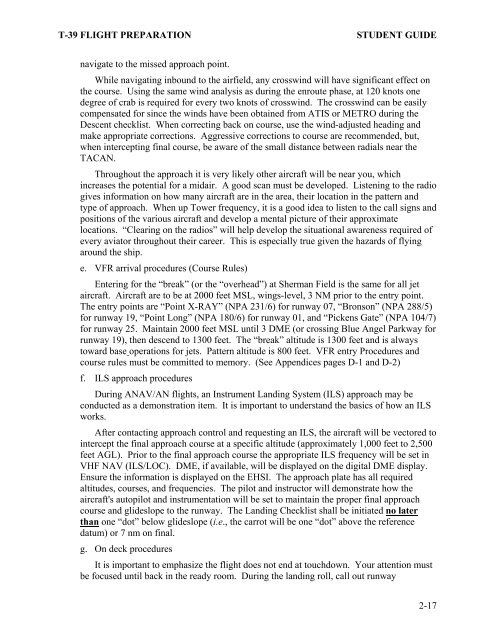t-39 - Chief of Naval Air Training
t-39 - Chief of Naval Air Training
t-39 - Chief of Naval Air Training
You also want an ePaper? Increase the reach of your titles
YUMPU automatically turns print PDFs into web optimized ePapers that Google loves.
T-<strong>39</strong> FLIGHT PREPARATION STUDENT GUIDE<br />
navigate to the missed approach point.<br />
While navigating inbound to the airfield, any crosswind will have significant effect on<br />
the course. Using the same wind analysis as during the enroute phase, at 120 knots one<br />
degree <strong>of</strong> crab is required for every two knots <strong>of</strong> crosswind. The crosswind can be easily<br />
compensated for since the winds have been obtained from ATIS or METRO during the<br />
Descent checklist. When correcting back on course, use the wind-adjusted heading and<br />
make appropriate corrections. Aggressive corrections to course are recommended, but,<br />
when intercepting final course, be aware <strong>of</strong> the small distance between radials near the<br />
TACAN.<br />
Throughout the approach it is very likely other aircraft will be near you, which<br />
increases the potential for a midair. A good scan must be developed. Listening to the radio<br />
gives information on how many aircraft are in the area, their location in the pattern and<br />
type <strong>of</strong> approach. When up Tower frequency, it is a good idea to listen to the call signs and<br />
positions <strong>of</strong> the various aircraft and develop a mental picture <strong>of</strong> their approximate<br />
locations. “Clearing on the radios” will help develop the situational awareness required <strong>of</strong><br />
every aviator throughout their career. This is especially true given the hazards <strong>of</strong> flying<br />
around the ship.<br />
e. VFR arrival procedures (Course Rules)<br />
Entering for the “break” (or the “overhead”) at Sherman Field is the same for all jet<br />
aircraft. <strong>Air</strong>craft are to be at 2000 feet MSL, wings-level, 3 NM prior to the entry point.<br />
The entry points are “Point X-RAY” (NPA 231/6) for runway 07, “Bronson” (NPA 288/5)<br />
for runway 19, “Point Long” (NPA 180/6) for runway 01, and “Pickens Gate” (NPA 104/7)<br />
for runway 25. Maintain 2000 feet MSL until 3 DME (or crossing Blue Angel Parkway for<br />
runway 19), then descend to 1300 feet. The “break” altitude is 1300 feet and is always<br />
toward base operations for jets. Pattern altitude is 800 feet. VFR entry Procedures and<br />
course rules must be committed to memory. (See Appendices pages D-1 and D-2)<br />
f. ILS approach procedures<br />
During ANAV/AN flights, an Instrument Landing System (ILS) approach may be<br />
conducted as a demonstration item. It is important to understand the basics <strong>of</strong> how an ILS<br />
works.<br />
After contacting approach control and requesting an ILS, the aircraft will be vectored to<br />
intercept the final approach course at a specific altitude (approximately 1,000 feet to 2,500<br />
feet AGL). Prior to the final approach course the appropriate ILS frequency will be set in<br />
VHF NAV (ILS/LOC). DME, if available, will be displayed on the digital DME display.<br />
Ensure the information is displayed on the EHSI. The approach plate has all required<br />
altitudes, courses, and frequencies. The pilot and instructor will demonstrate how the<br />
aircraft's autopilot and instrumentation will be set to maintain the proper final approach<br />
course and glideslope to the runway. The Landing Checklist shall be initiated no later<br />
than one “dot” below glideslope (i.e., the carrot will be one “dot” above the reference<br />
datum) or 7 nm on final.<br />
g. On deck procedures<br />
It is important to emphasize the flight does not end at touchdown. Your attention must<br />
be focused until back in the ready room. During the landing roll, call out runway<br />
2-17
















